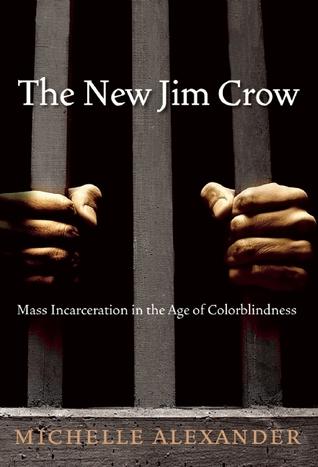Book: The New Jim Crow: Mass Incarceration in the Age of Colorblindness by Michelle Alexander
Genre: Nonfiction
Publisher: The New Press
Publication date: 2010
Pages: 248
Source: Library (and it’s overdue!)
 Summary: What you think you know about crime, criminals, the drug war, prisons, prisoners, former prisoners, and the American justice system is wrong. The reality is much more complicated than you imagine and much more racist than you would like to believe could be possible in modern America. The system is primed to perpetuate itself for generations. It’s not clear how to fix it, but it is clear that awareness is the first step. The New Jim Crow by Michelle Alexander provides the awareness.
Summary: What you think you know about crime, criminals, the drug war, prisons, prisoners, former prisoners, and the American justice system is wrong. The reality is much more complicated than you imagine and much more racist than you would like to believe could be possible in modern America. The system is primed to perpetuate itself for generations. It’s not clear how to fix it, but it is clear that awareness is the first step. The New Jim Crow by Michelle Alexander provides the awareness.
Thoughts: The New Jim Crow by Michelle Alexander was the June selection for our Diversity Book Club (Fifth Anniversary of Kirkwood City Hall Shooting). This was arguably the most important book we’ve read in the five years that we’ve been meeting.
A lot of information wasn’t new to us because we’ve been studying the issue of race in America, but would be news to most Americans. By pulling together pieces that we learned from other books about slavery, separation, and migration and adding in new things about the unequal enforcement of drug laws, Michelle Alexander taught even our fairly knowledgeable group a more accurate way of viewing the world.
Here’s one startling revelation:
The notion that whites comprise the vast majority of drug users and dealers–and may well be more likely than other racial groups to commit drug crimes–may seem implausible to some, given the media imagery we are fed on a daily basis and the racial composition of our prisons and ails. Upon reflection, however, the prevalence of white drug crime–including drug dealing–should not be surprising. After all, where do whites get their illegal drugs? Do they all drive to the ghetto to purchase them from somebody standing on a street corner? No. Studies consistently indicate that drug markets, like American society generally, reflect our nation’s racial and socioeconomic boundaries. Whites tend to sell to whites; blacks to blacks. University students tend to sell to each other. Rural whites, for their part, don’t make a special trip to the ‘hood to purchase marijuana. They buy it from someone down the road. White high school students typically buy drugs form white classmates, friends, or older relatives. Even Barry McCaffrey, former director of the White House Office of National Drug Control Policy, once remarked, if your child bought drugs, “it was from a student of their own race generally.” The notion that most illegal drug use and sales happens in the ghetto is pure fiction. Drug trafficking occurs there, but it occurs everywhere else in America as well. Nevertheless black men have been admitted to state prison on drug charges at a rate that is more than thirteen times higher than white men. The racial bias in the drug war is a major reason that 1 in every 14 black men was behind bars in 2006, compared to 1 in 106 white men. For young black men, the statistics are even worse. One in 9 black men between the ages of twenty and thirty-five was behind bars in 2006, and far more were under some form of penal control–such as probation or parole. These gross racial disparities simply cannot be explained by rates of illegal drug activity among African Americans. (pp. 97, 98)
This well-researched book (the above paragraph had 7 end notes) illuminated parts of America that most of us choose not to see. Law enforcement activities against law-abiding citizens that would not be tolerated in suburban or rural white communities are routine in black ones, including a visceration of Fourth Amendment rights against unreasonable search and seizure supported by recent court decisions. The power of prosecutors is absolute resulting in unequally applied discretion to pursue or not pursue charges with no oversight. We claim that everyone has a right to a defense, but grossly under-fund public defenders. Sentencings are ludicrous when compared against the relative impact of the crime on society (try comparing the punishments meted out to drunk drivers versus drug offenders). Our inability to develop a coherent vision of what should happen once a prisoner has paid his debt to society has led to a system of restrictions, fees, and stigmas that makes it nearly impossible for him to function in society any meaningful way.
How can there be a new Jim Crow in a modern America that embraces its colorblindness and publicly shames those who remind us of past bigotries that we would rather forget?
Claims that mass incarceration is analogous to Jim Crow will fall on deaf ears and alienate potential allies if advocates fail to make clear that the claim is not meant to suggest or imply that supporters of the current system are racist in the way Americans have come to understand that term. Race plays a major role–indeed, a defining role–in the current system, but not because of what is commonly understood as old-fashioned, hostile bigotry. This system of control depends far more on racial indifference (defined as a lack of compassion and caring about race and racial groups) than racial hostility…. (p. 198)
Since I’ve read this book, nearly every domestic news story, and the occasional international one, has a new twist or foundation or tone that is invisible to most viewers and, apparently, the reporters, but that I can now see. I ask new questions and issue new challenges to the people around me and to society as a whole. We can do better than be the country with the highest percentage of our population incarcerated. We can do better than to have that mass incarceration be nominally color blind while, in fact, be applied so disproportionately to people of color that if we weren’t pretending we were color blind it would have been obvious long ago. We can do better than forget our racial history as if it never happened and pretend that it has no effect today when it clearly does and is ruining lives at this very moment.
Seeing race is not the problem. Refusing to care for the people we see is the problem. The fact that the meaning of race may evolve over time or lose much of its significance is hardly a reason to be struck blind. We should hope not for a colorblind society but instead for a world in which we can see each other fully, learn from each other, and do what we can to respond to each other with love. That was King’s dream–a society that is capable of seeing each of us, as we are, with love. That is a goal worth fighting for. (p. 231)
Appeal: If you live in the US, please read this book.
Reviews: Other Reviews
- A Striped Armchair: The New Jim Crow by Michelle Alexander (thoughts)
- BookeyWookey: A cruel hand laid upon American citizens (Books – The New Jim Crow by Michelle Alexander)
Have you read this book? What did you think?

